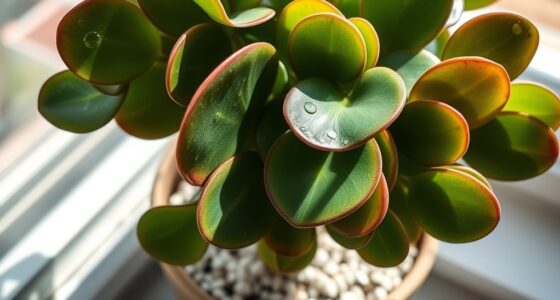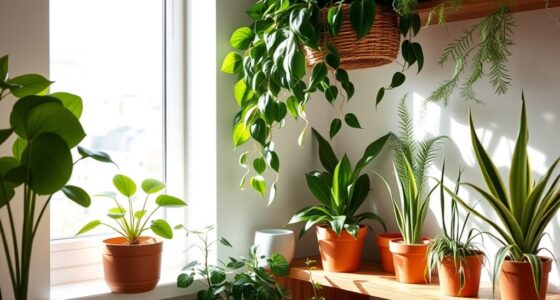If you’re after low-maintenance houseplants that practically never die, consider snake plants, pothos, ZZ plants, water-loving varieties like pothos and ZZ, and succulents. These hard-to-kill options thrive on infrequent watering, tolerate low to bright indirect light, and handle neglect well. They’re perfect for busy or forgetful plant owners, and with some simple tips, you’ll find these greenery choices almost impossible to kill. Keep going to discover the secrets behind each of these resilient houseplants.
Key Takeaways
- Snake Plants tolerate low light and infrequent watering, making them ideal for neglectful owners.
- Pothos thrive in various light conditions and recover quickly from over- or underwatering.
- ZZ Plants require minimal watering and can survive in low light, showcasing exceptional resilience.
- Succulents prefer bright sunlight and infrequent watering, thriving with minimal care and drought tolerance.
- These plants collectively withstand neglect, varying environments, and inconsistent watering routines, earning their “unkillable” reputation.

If you’ve ever struggled to keep houseplants alive, you’ll be pleased to discover that some plants are virtually impossible to kill. These unkillable houseplants are perfect for beginners or anyone who wants greenery without the stress of constant care. They’re resilient, forgiving, and adaptable, making them ideal for busy lifestyles or forgetful plant lovers. The key to thriving with these plants is understanding their basic needs, especially their watering frequency and light requirements. Luckily, most of these hardy varieties are quite flexible, tolerating a range of conditions.
These nearly indestructible houseplants are perfect for busy or forgetful plant lovers.
For instance, snake plants, also known as sansevieria, require minimal watering—about once every two to three weeks—and can handle neglect better than most. They thrive in bright, indirect light but can also survive in low light conditions, making them perfect for offices or dim corners. Their thick, upright leaves store water, so you don’t need to worry about overwatering. Their ability to tolerate varying light requirements and infrequent watering makes them virtually unkillable, even if you forget to water them for a little while.
Another fantastic option is pothos, which are famously adaptable. They prefer moderate to bright indirect light but can tolerate lower light levels, which means they won’t complain if your windows are a bit shady. When it comes to watering, wait until the top inch of soil is dry before watering again, usually every week or two. Pothos are known for their forgiving nature; they can handle occasional over- or underwatering, and their trailing vines will bounce back quickly. Their hardy disposition makes them a favorite among novice plant owners.
ZZ plants are also incredibly resilient. They thrive in low light or bright, indirect sunlight and only need watering every few weeks—once the soil has dried out completely. Their waxy, hearty leaves help retain moisture, so you don’t need to be precise with watering frequency. ZZ plants are forgiving of irregular watering schedules and can withstand drought-like conditions, which further cements their reputation as unkillable.
Additionally, some popular water-loving plants like pothos and ZZ plants can benefit from humidity levels that are often found in typical homes, helping them thrive even in less-than-ideal environments.
Lastly, succulents like aloe vera or jade plants are excellent choices for those who prefer minimal care. They love bright, direct sunlight and require very little watering—about once a month or even less. Their thick, fleshy leaves store water efficiently, allowing them to survive periods of drought. With their low light requirements and infrequent watering needs, succulents are almost impossible to kill, especially if you let the soil dry out completely between waterings.
In short, these plants are your best allies if you want vibrant greenery without the hassle. Understanding their light needs and watering frequency will help you keep them healthy, but even if you occasionally forget, they’ll likely survive and thrive under your care.
Frequently Asked Questions
Can Unkillable Houseplants Survive in Low-Light Conditions?
Many unkillable houseplants can survive in low-light conditions thanks to their shade tolerance. You’ll find that these plants, like pothos or snake plants, adapt well to low light survival, thriving even in dim corners. Their ability to tolerate shade makes them ideal for spaces with minimal sunlight. Just remember to avoid overwatering, as low light can slow their growth, but overall, they’re perfect for low-light environments.
How Often Should I Water These Hard-To-Kill Plants?
Imagine a gentle rain nurturing a resilient plant; that’s how your hard-to-kill houseplants thrive. You should water them when the soil moisture feels dry to the touch, usually every 1-2 weeks. Keep an eye on soil moisture levels, as overwatering can lead to root rot. Adjust watering frequency based on the season and indoor conditions, ensuring your plants stay healthy and happy with minimal effort.
Are These Plants Safe for Pets and Children?
You wonder if these plants are safe for pets and children. While many hard-to-kill houseplants are generally non-toxic, some can be harmful if ingested. To guarantee pet safety and child safety, always verify specific plant species and keep potentially toxic ones out of reach. It’s best to choose non-toxic options and educate kids about not eating houseplants, so everyone stays safe while enjoying your green space.
Do Unkillable Houseplants Require Fertilization?
You might wonder if unkillable houseplants need fertilization. Generally, they have minimal fertilizer needs because they’re hardy and adapted to survive with less. However, to meet their nutrient requirements and keep them thriving, you should occasionally provide a balanced fertilizer. This helps guarantee they get essential nutrients without overfeeding. Just remember, these plants are resilient, so don’t stress if you forget fertilizing sometimes—they’ll still do well.
Can These Plants Tolerate Temperature Fluctuations Indoors?
They say “a stitch in time saves nine,” and that applies to managing your houseplants’ health. These hardy plants generally have good temperature resilience and indoor climate adaptability, so they can tolerate some temperature fluctuations indoors. However, sudden or extreme changes might stress them out. Keep your home environment stable, avoid drafts, and they’ll thrive, proving that resilience is key to keeping your plants happy and healthy.
Conclusion
Think of these houseplants as your garden’s resilient warriors, standing tall through every mistake and neglect. They’re like the unbreakable stars in your indoor galaxy, shining bright even when you forget to water or prune. With a little care, they’ll thrive and bring life to your space, proving that even the toughest plants can become your loyal companions. Embrace their hardy spirit, and watch your home bloom with minimal effort.









